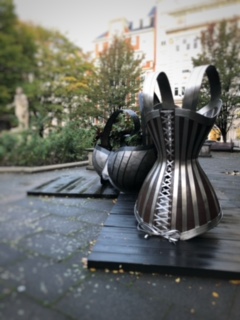I had a minor operation to fix a problem with my knee earlier this week. The injury has meant that I haven’t done much walking of late and the residual soreness from the surgery has made sleeping difficult this week. While my wife gently snored next to me last night I tossed and turned for an hour or so before reaching for my headphones to tune into an audiobook. I’d started listening to Nicholas Nickelby, one of my favourite Charles Dickens’ novels earlier in the day and last night reached the point where we encounter Ralph Nickelby at his offices in Golden Square.
This is how Dickens describes the Square in that novel which was published in serial form between 1838 to 1839:
Although a few members of the graver professions live about Golden Square, it is not exactly in anybody’s way to or from anywhere. It is one of the squares that have been; a quarter of the town that has gone down in the world, and taken to letting lodgings. Many of its first and second floors are let, furnished, to single gentlemen; and it takes boarders besides. It is a great resort of foreigners. The dark-complexioned men who wear large rings, and heavy watch-guards, and bushy whiskers, and who congregate under the Opera Colonnade, and about the box-office in the season, between four and five in the afternoon, when they give away the orders,—all live in Golden Square, or within a street of it. Two or three violins and a wind instrument from the Opera band reside within its precincts. Its boarding-houses are musical, and the notes of pianos and harps float in the evening time round the head of the mournful statue, the guardian genius of a little wilderness of shrubs, in the centre of the square. On a summer’s night, windows are thrown open, and groups of swarthy moustached men are seen by the passer-by, lounging at the casements, and smoking fearfully. Sounds of gruff voices practising vocal music invade the evening’s silence; and the fumes of choice tobacco scent the air. There, snuff and cigars, and German pipes and flutes, and violins and violoncellos, divide the supremacy between them. It is the region of song and smoke. Street bands are on their mettle in Golden Square; and itinerant glee- singers quaver involuntarily as they raise their voices within its boundaries.
Dickens also set a scene in David Copperfield near the square. Daniel Peggotty finally tracks Emily down to the local vicinty when she had fallen on hard times.
I was early for a breakfast meeting some weeks ago and found myself kicking my heels in Golden Square, so, of course, I whipped out my phone and took some photos.
Sadly there was no music escaping the windows of the square during my visit, but there is still a statue in the middle of the square. It is George II according to the information board in the corner of the gardens. He had a pigeon on his head the morning I visited.

There were some strange modern sculptures keeping George company. Not only the green worm called Lockdown by dollyolli.com which is my featured photo but also what looked to me like a metallic interpretation of Madonna’s corset and bra from the 90’s, which is by Kalliopi Lemos. Neither were to my taste but they added a certain jolliness to proceedings.

Golden Square is probably a derviation of Geldings Square and it is likely horses were stabled here before the Georgian square was developed. There is not a lot of that left. The original houses were originally occupied by high society – William Pitt the Elder was born here – before several embassies moved in during the middle of the 18th Century.These were attacked and damaged by the anti-Catholic Gordon riots of 1780 (which Dickens featured in his first historical novel, Barnaby Rudge). The real damage was caused in the late 19th Century when the square became a centre of the wool industry and many houses were pulled down to be replaced by warehouses and offices. These too are now gone, superceded by modern buildings.



